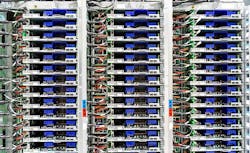Google will soon begin using geothermal energy to power its data centers in Nevada with carbon-free energy, the company said today. Google becomes the first hyperscale cloud operator to tap the earth’s own heat to power its servers, an approach that can provide green energy around the clock, addressing one of the key challenges with wind and solar energy.
Google will work with clean-energy startup Fervo Energy to develop a next-generation geothermal power project that will begin adding carbon-free energy to the Nevada power grid in 2022. The system will use underground fiber optic cables as sensors to identify the best locations to find geothermal energy.
“This collaboration also sets the stage for next-generation geothermal to play a role as a firm and flexible carbon-free energy source that can increasingly replace carbon-emitting fossil fuels — especially when aided by policies that expand and improve electricity markets; incentivize deployment of innovative technologies; and increase investments in clean energy.” said Michael Terrell, Director of Energy at Google.
“Not only does this Fervo project bring our data centers in Nevada closer to round-the-clock clean energy, but it also acts as a proof-of-concept to show how firm clean energy sources such as next-generation geothermal could eventually help replace carbon-emitting power sources around the world,” said Terrell.
Nevada is emerging as a primary testbed for Google’s ambitions to work closely with the utility industry in developing dynamic ecosystems to support renewable energy. Google is working with NV Energy to provision 350 megawatts of solar energy and 280 megawatts of energy storage to support its data center campus in Henderson, a suburb of Las Vegas. Data center technology provider Switch is also pursuing energy innovation in Nevada, creating a555 megawatt solar energy project and adding energy storage technology from Tesla to boost its use of solar energy for its data center campuses in Las Vegas and Reno.
Google also said that it has begun moving workloads between data centers to boost its use of renewable energy, a development that creates powerful new opportunities to green create cloud applications powered by solar, wind and geothermal energy. The company is also deploying large batteries to replace the diesel generators at one of its data centers in Belgium, describing the project as a first step towards using cleaner technologies to provide backup power for its millions of servers around the world.
All of these innovations support Google’s drive to power its global information empire entirely with carbon-free energy by 2030, matching every hour of its data center operations to carbon-free energy sources,
Using Fiber to Make Wells Smarter
The earth is a powerful source of heat, with an inner core that reaches nearly 10,000 degrees F. Small portions of this heat are released through geologic formations to create hot spots and seismic activity. Geothermal energy harnesses heat from these hot spots, typically through deep injection wells. The U.S. currently has about 3.7 gigawatts of geothermal energy, which is also widely used in Iceland.
Because of cost and location constraints, geothermal still accounts for a small percentage of global clean energy production. The US Department of Energy projects that with as extraction techniques and policies are refined, geothermal energy could provide up to 120 gigawatts (GWs) of generation capacity in the U.S. by 2050.
Fervo’s approach harnesses technology to develop smarter wells.
“Using fiber-optic cables inside wells, Fervo can gather real-time data on flow, temperature, and performance of the geothermal resource,” said Terrell in a blog post. “This data allows Fervo to identify precisely where the best resources exist, making it possible to control flow at various depths. Coupled with the AI and machine learning development outlined above, these capabilities can increase productivity and unlock flexible geothermal power in a range of new places.”
Earth scientists have used dark fiber for seismic activity monitoring and earthquake detection through a technique known as distributed acoustic sensing, which uses the backscatter from interruptions in fiber-optic light pulses to infer movement and map underground activity. These techniques have been used in the oil and gas industry, and
Google is partnering with Fervo to develop AI and machine learning tools that could boost the productivity of next-generation geothermal and make it more effective at responding to demand from utility grids, especially in supplementing other renewable sources like wind and solar power. “Although this project is still in the early stages, it shows promise,” said Google.
The initial phase of the collaboration between Google and Fervo is expected to generate approximately 5 MWs of round-the-clock-power for the grid. That’s not a huge amount of power for Google, which can use hundreds of megawatts at one of its data center campuses. But if the technology performs well, it could pave the way for scaling up and being deployed in more locations.
About the Author



